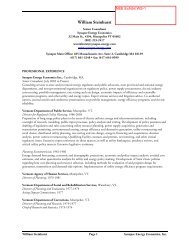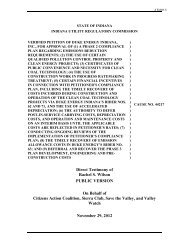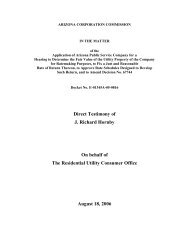Best Practices in Energy Efficiency Program Screening - Synapse ...
Best Practices in Energy Efficiency Program Screening - Synapse ...
Best Practices in Energy Efficiency Program Screening - Synapse ...
Create successful ePaper yourself
Turn your PDF publications into a flip-book with our unique Google optimized e-Paper software.
2. Tests for Screen<strong>in</strong>g <strong>Energy</strong> <strong>Efficiency</strong> <strong>Program</strong>s<br />
2.1 Description of the Cost-Effectiveness Tests<br />
The costs and benefits of energy efficiency are qualitatively different from those of<br />
supply-side resources <strong>in</strong> that they can have different implications for different parties. As<br />
a result, five cost-effectiveness tests have been developed to consider efficiency costs<br />
and benefits from different perspectives. 3 Each of these tests comb<strong>in</strong>es the various costs<br />
and benefits of energy efficiency programs <strong>in</strong> different ways, depend<strong>in</strong>g upon which<br />
costs and which benefits perta<strong>in</strong> to the different parties. These tests are described<br />
below and summarized <strong>in</strong> Table 2.1. 4<br />
The Societal Cost Test. 5 This test <strong>in</strong>cludes the costs and benefits experienced by<br />
all members of society. The costs <strong>in</strong>clude all of the costs <strong>in</strong>curred by any member<br />
of society: the program adm<strong>in</strong>istrator, the customer, and anyone else. Similarly,<br />
the benefits <strong>in</strong>clude all of the benefits experienced by any member of society. The<br />
costs and benefits are the same as for the TRC Test, except that they also <strong>in</strong>clude<br />
externalities, such as environmental costs and reduced costs for government<br />
services.<br />
The Total Resource Cost (TRC) Test. This test <strong>in</strong>cludes the costs and benefits<br />
experienced by all utility customers, <strong>in</strong>clud<strong>in</strong>g both program participants and nonparticipants.<br />
The costs <strong>in</strong>clude all the costs <strong>in</strong>curred by the program adm<strong>in</strong>istrator<br />
and participat<strong>in</strong>g customer, <strong>in</strong>clud<strong>in</strong>g the full <strong>in</strong>cremental cost of the efficiency<br />
measure, regardless of whether it was <strong>in</strong>curred by the program adm<strong>in</strong>istrator or<br />
the participat<strong>in</strong>g customers. 6 The benefits <strong>in</strong>clude all the avoided utility costs, plus<br />
any other program benefits experienced by the customers, such as avoided water<br />
costs, reduced operations and ma<strong>in</strong>tenance costs, improved comfort levels, health<br />
and safety benefits, and more.<br />
The <strong>Program</strong> Adm<strong>in</strong>istrator Cost (PAC) Test. 7 This test <strong>in</strong>cludes the energy costs<br />
and benefits that are experienced by the energy efficiency program adm<strong>in</strong>istrator.<br />
This test is most consistent with the way that supply-side resources are evaluated<br />
by vertically <strong>in</strong>tegrated utilities. The costs <strong>in</strong>clude all expenditures by the program<br />
adm<strong>in</strong>istrator to design, plan, adm<strong>in</strong>ister, deliver, monitor and evaluate efficiency<br />
programs offset by any revenue from the sale of freed up energy supply. The<br />
benefits <strong>in</strong>clude all the avoided utility costs, <strong>in</strong>clud<strong>in</strong>g avoided energy costs,<br />
avoided capacity costs, avoided transmission and distribution costs, and any other<br />
costs <strong>in</strong>curred by the utility to provide electric services (or gas services <strong>in</strong> the case<br />
of gas energy efficiency programs).<br />
3 For additional <strong>in</strong>formation on these tests, see CA PUC 2001 and NAPEE 2008.<br />
4 These tests are sometimes def<strong>in</strong>ed slightly differently by different Public Utilities Commissions. Some<br />
states have created additional tests (e.g., ODC 2012; MEA 2011).<br />
5 The California Standard Practice Manual (SPM) considers the Societal Cost Test a variant on the TRC<br />
test (CA PUC 2001, p 18). Many states and studies depart from the SPM by draw<strong>in</strong>g a more complete<br />
dist<strong>in</strong>ction between these two tests.<br />
6 The <strong>in</strong>cremental measure cost is the difference between the cost of the efficiency measure and the cost<br />
of the most relevant basel<strong>in</strong>e equipment that would have been <strong>in</strong>stalled <strong>in</strong> the absence of the program.<br />
7 This is sometimes referred to as the Utility Cost test or the <strong>Energy</strong> System test.<br />
| 12 <strong>Best</strong> <strong>Practices</strong> <strong>in</strong> <strong>Energy</strong> <strong>Efficiency</strong> <strong>Program</strong> Screen<strong>in</strong>g | www.nhpci.org







